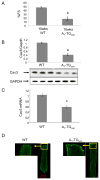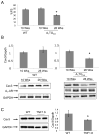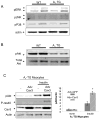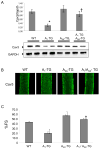Left ventricular dysfunction in murine models of heart failure and in failing human heart is associated with a selective decrease in the expression of caveolin-3
- PMID: 21362533
- PMCID: PMC3073520
- DOI: 10.1016/j.cardfail.2010.10.008
Left ventricular dysfunction in murine models of heart failure and in failing human heart is associated with a selective decrease in the expression of caveolin-3
Abstract
Background: Caveolins are scaffolding proteins that are integral components of caveolae, flask-shaped invaginations in the membranes of all mammalian cells. Caveolin-1 and -2 are expressed ubiquitously, whereas caveolin-3 is found only in muscle. The role of caveolin-3 in heart muscle disease is controversial.
Methods and results: The present study was undertaken to assess the effects of left ventricular dysfunction on the expression of caveolin proteins using 2 well characterized models of murine heart failure and failing human heart. Transgenic mice with constitutive overexpression of A(1)-adenosine receptor (A(1)-TG) demonstrated cardiac dilatation and decreased left ventricular function at 10 weeks of age. This was accompanied by a marked decrease in caveolin-3 mRNA and protein levels compared with non-TG control mice. The change in caveolin-3 expression was selective, because levels of caveolin-1 and -2 did not change. Confocal imaging of myocytes isolated from A(1)-TG mice demonstrated a loss of the plate-like appearance of T tubules. Caveolin-3 levels were also reduced in hearts from mice overexpressing tumor necrosis factor α. There was a direct relationship between caveolin-3 expression and fractional shortening in all mice that were studied (r = 0.65; P < .001). Although we could not demonstrate a significant decrease in caveolin-3 levels in failing human heart, we did find a direct correlation (r = 0.7; P < .05) between levels of caveolin-3 protein and Ca(2+)-adenosine triphosphatase, a marker of the heart failure phenotype.
Conclusions: These results suggest a relationship between left ventricular dysfunction and caveolin-3 levels and suggest that caveolin-3 may provide a novel target for heart failure therapy.
Copyright © 2011 Elsevier Inc. All rights reserved.
Figures








References
-
- Isshiki MAR. Calcium signal transduction from caveolae. Cell Calcium. 1999;26:201–8. - PubMed
-
- Isshiki MAJ, Yamamoto K, Fujita T, Ying Y, Anderson RGW. Sites of Ca(2+) wave initiation move with caveolae to the trailing edge of migrating cells. J Cell Sci. 2002;115:475–84. - PubMed
-
- Lasley RDNP, Uittenbogaard A, Smart EJ. Activated cardiac adenosine A1 receptors translocate out of caveolae. J Biol Chem. 2000;275:4417–21. - PubMed
-
- Escriche MBJ, Ciruela F, Canela EI, Mallol J, Enrich C, Lluis C, Franco R. Ligand-induced caveolae-mediated internalization of A1 adenosine receptors: morphological evidence of endosomal sorting and receptor recycling. Experimental Cell Research. 2003;285:72–90. - PubMed
Publication types
MeSH terms
Substances
Grants and funding
- HL 075443/HL/NHLBI NIH HHS/United States
- HL 58672/HL/NHLBI NIH HHS/United States
- HL 085503/HL/NHLBI NIH HHS/United States
- P01 HL075443/HL/NHLBI NIH HHS/United States
- R01 HL061690/HL/NHLBI NIH HHS/United States
- R01 HL074854/HL/NHLBI NIH HHS/United States
- P01 HL091799/HL/NHLBI NIH HHS/United States
- R01 HL085503/HL/NHLBI NIH HHS/United States
- R01 HL058672/HL/NHLBI NIH HHS/United States
- HL 74854/HL/NHLBI NIH HHS/United States
- HL 061690/HL/NHLBI NIH HHS/United States
- HL 091799-01/HL/NHLBI NIH HHS/United States
- R37 HL061690/HL/NHLBI NIH HHS/United States
LinkOut - more resources
Full Text Sources
Medical
Miscellaneous

